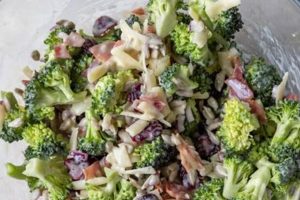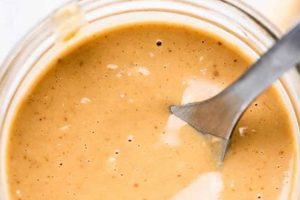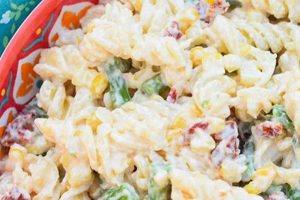A guide to creating a flavorful condiment featuring the sweetness of onions as a base often involves a combination of pureed or finely diced onions, oil (such as olive oil or vegetable oil), an acidic element (vinegar or citrus juice), and seasonings. Sweetness can be enhanced with sugar, honey, or other sweeteners. Variations may include herbs, spices, or other vegetables. An example might involve slow-cooked caramelized onions blended with balsamic vinegar, olive oil, Dijon mustard, and a touch of honey.
This type of condiment offers a versatile way to enhance salads, sandwiches, and other dishes. The balance of sweet and tangy flavors adds complexity and depth, elevating simple ingredients. Historically, onions have played a significant role in culinary traditions worldwide, and their use in dressings showcases their adaptable nature. Such dressings provide a flavorful alternative to traditional options, catering to diverse palates and dietary preferences, particularly for those seeking a lower-fat, flavorful alternative to creamy dressings.
The following sections will delve into specific ingredient selections, preparation techniques, variations, and serving suggestions for creating and utilizing this versatile condiment.
Tips for Crafting Exceptional Sweet Onion Salad Dressing
Creating a truly exceptional sweet onion dressing involves attention to detail and a balance of flavors. The following tips offer guidance for achieving optimal results.
Tip 1: Onion Selection Matters: Opt for sweeter onion varieties like Vidalia, Walla Walla, or Maui. Their inherent sweetness provides the perfect foundation.
Tip 2: Caramelization Enhances Flavor: Slow-cooking the onions until caramelized intensifies their sweetness and adds depth of flavor.
Tip 3: Balance Sweet and Tangy Elements: Achieve harmony by carefully balancing the sweetness of the onions with the acidity of vinegar or citrus juice. Taste and adjust accordingly.
Tip 4: Oil Selection Impacts Flavor Profile: Consider the flavor profile of the oil. Extra virgin olive oil lends a robust flavor, while a neutral oil allows the onion’s sweetness to shine.
Tip 5: Emulsification Creates a Creamy Texture: Proper emulsification of the oil and acidic elements creates a smooth, creamy texture that clings to salad ingredients.
Tip 6: Seasoning Enhances Complexity: Enhance the dressing’s complexity with seasonings like Dijon mustard, salt, pepper, or herbs such as thyme or oregano.
Tip 7: Freshness is Key: Use fresh, high-quality ingredients for the best flavor and texture. Store the dressing properly in a sealed container in the refrigerator.
By following these tips, one can achieve a balanced and flavorful dressing that elevates any salad or dish. The combination of sweet caramelized onions, balanced acidity, and carefully selected seasonings creates a delightful culinary experience.
The insights and techniques provided throughout this article equip readers with the knowledge to create a versatile and delicious sweet onion salad dressing, enhancing culinary creations.
1. High-quality Ingredients
The quality of ingredients directly impacts the final flavor profile of a sweet onion salad dressing. Superior ingredients contribute nuanced flavors and desirable textures, elevating the overall sensory experience. Fresh, flavorful onions, for example, provide a natural sweetness that requires less manipulation with added sugars. High-quality oils contribute desirable mouthfeel and flavor complexity, while premium vinegars offer a balanced acidity that complements the sweetness of the onions. The use of fresh herbs and spices further enhances the overall complexity and freshness of the dressing.
Consider the difference between a dressing made with standard yellow onions versus one made with sweet Vidalia onions. The Vidalia onion’s inherent sweetness and delicate flavor create a more nuanced and complex dressing. Similarly, using a robust extra virgin olive oil adds depth and fruitiness compared to a generic vegetable oil. Investing in quality balsamic vinegar offers a more complex, mellow acidity compared to a standard distilled vinegar. These distinctions demonstrate the tangible impact of ingredient quality on the final product.
Understanding the importance of high-quality ingredients empowers one to create a superior sweet onion salad dressing. While substitutions may be necessary at times, prioritizing quality whenever possible yields optimal results. This principle applies not only to sweet onion dressings but to culinary endeavors in general. The pursuit of quality ingredients ensures a more rewarding and flavorful culinary experience.
2. Proper Onion Preparation
Proper onion preparation is fundamental to a successful sweet onion salad dressing. The way onions are handled determines their final flavor and texture, significantly impacting the overall quality of the dressing. From selection to slicing and cooking methods, each step plays a crucial role in achieving the desired balance of sweetness and pungency.
- Onion Variety Selection
Choosing the right onion variety is paramount. Sweet onions like Vidalia, Walla Walla, or Maui are preferred for their inherent sweetness and mild flavor. These varieties offer a balanced sweetness that complements the other dressing components without overpowering them. Using a strong onion like a red onion would result in a sharper, more pungent dressing, potentially clashing with the desired sweet and tangy profile.
- Slicing Technique
The way onions are sliced influences both texture and flavor release. Thinly sliced onions offer a delicate texture and readily release their flavor into the dressing. Conversely, thicker slices provide more textural presence but may not fully infuse the dressing with their sweetness. Dicing the onions finely allows for even distribution of flavor and a smooth consistency, crucial for a well-emulsified dressing.
- Cooking Method
The cooking method significantly impacts the onion’s sweetness and overall flavor profile. Caramelizing the onions slowly over low heat coaxes out their natural sugars, intensifying their sweetness and adding depth of flavor. Raw onions, while offering a sharp bite, lack the mellow sweetness achieved through caramelization. Alternatively, roasting onions can impart a smoky sweetness. The chosen cooking method should align with the desired flavor profile of the final dressing.
- Maceration and Infusion
After cooking or slicing, allowing the onions to macerate in the dressing’s acidic component (like vinegar or citrus juice) further enhances flavor development and softens their texture. This process allows the onions to release their flavors more fully into the dressing, creating a more cohesive and balanced final product. The maceration time, even as short as 15 minutes, can significantly influence the final intensity of the onion flavor within the dressing.
These facets of onion preparation collectively contribute to the overall success of a sweet onion salad dressing. Careful consideration of onion variety, slicing technique, cooking method, and maceration ensures a balanced, flavorful, and texturally appealing dressing. By mastering these techniques, one can elevate a simple salad dressing into a culinary highlight. The interplay of these factors determines the final character of the dressing, showcasing the importance of proper onion preparation in achieving the desired outcome.
3. Balanced Flavor Profile
A balanced flavor profile is paramount in a successful sweet onion salad dressing. The delicate interplay of sweet, tangy, and savory elements defines its character. This balance prevents any single flavor from dominating, creating a harmonious and complex taste experience. The sweetness of the onions, derived from their natural sugars and enhanced by caramelization, forms the foundation. However, unchecked sweetness can become cloying. Therefore, acidity is crucial. Vinegar or citrus juice provides the necessary tartness to counterbalance the sweetness, creating a vibrant and refreshing taste. The type of acid employed influences the final profile. A balsamic vinegar contributes a mellow sweetness, while a rice vinegar offers a lighter, brighter acidity. Beyond sweet and sour, savory elements add depth and complexity. Ingredients like Dijon mustard, Worcestershire sauce, or even a pinch of salt enhance the overall flavor, preventing the dressing from tasting one-dimensional. For instance, a dressing featuring caramelized Vidalia onions, balanced with apple cider vinegar and a touch of Dijon mustard, exemplifies a harmonious flavor profile. The interplay of sweet onion, tart apple cider, and pungent mustard creates a well-rounded, flavorful dressing.
Achieving this balance requires careful consideration of ingredient ratios and individual flavor intensities. The inherent sweetness of the onion variety chosen influences the amount of acid required. A sweeter onion necessitates more acid to maintain equilibrium. Similarly, the intensity of the acid plays a role. A strong balsamic vinegar requires a smaller quantity compared to a milder rice vinegar. The addition of other savory elements further influences the balance. A touch of salt enhances sweetness and balances acidity, while a hint of black pepper adds complexity. Adjusting these elements incrementally while tasting allows for precise flavor calibration, ensuring a harmonious final product. Consider a scenario where the dressing tastes overly sweet. A judicious addition of vinegar or a squeeze of lemon juice can restore balance. Conversely, if the dressing is too tart, a touch of honey or maple syrup can temper the acidity. This iterative process of tasting and adjusting allows for fine-tuning the flavor profile to perfection.
A well-balanced flavor profile elevates a sweet onion salad dressing from simple to exceptional. This delicate equilibrium of sweet, sour, and savory components creates a dynamic and nuanced flavor experience. Understanding the interplay of these elements and the importance of incremental adjustments allows for consistent creation of a well-balanced and delicious dressing. This principle extends beyond sweet onion dressings, applying to a wide range of culinary creations. The pursuit of balance is fundamental to achieving flavorful and satisfying dishes. Mastering this principle allows one to create dressings that complement and enhance the ingredients they accompany, ultimately elevating the overall dining experience.
4. Effective Emulsification
Effective emulsification is crucial for the texture and stability of a sweet onion salad dressing. Emulsification refers to the process of combining two immiscible liquids, typically oil and an aqueous solution (like vinegar or citrus juice), into a stable mixture. In the context of a sweet onion dressing, effective emulsification prevents the oil and vinegar from separating, resulting in a smooth, creamy texture that clings to salad ingredients rather than pooling at the bottom of the bowl. This homogenous mixture ensures a consistent flavor distribution throughout the dressing, preventing pockets of excessive sweetness or acidity.
Several factors influence emulsification. The ratio of oil to vinegar plays a key role; a proper balance is essential for stability. The presence of an emulsifying agent further aids in creating a stable emulsion. Common emulsifying agents include Dijon mustard, egg yolks (though less common in vinaigrette-style dressings), or even finely pureed onion itself. These agents contain molecules with both hydrophilic (water-loving) and hydrophobic (oil-loving) properties, allowing them to bridge the gap between the oil and vinegar, creating a stable mixture. The method of combining ingredients also impacts emulsification. Slowly whisking the oil into the vinegar while constantly agitating the mixture encourages the formation of small oil droplets dispersed evenly throughout the vinegar, creating a stable emulsion. A blender or food processor can also achieve effective emulsification, though over-processing may lead to a thicker, less desirable texture.
The practical significance of effective emulsification is evident in the final product. A well-emulsified sweet onion dressing exhibits a smooth, creamy consistency, clinging evenly to salad ingredients and delivering a balanced flavor in every bite. Conversely, a poorly emulsified dressing separates quickly, resulting in an oily texture and uneven flavor distribution. This separation can negatively impact the overall sensory experience, making the salad less appealing. Therefore, achieving effective emulsification is essential for creating a high-quality, visually appealing, and palatable sweet onion salad dressing.
5. Versatile Applications
The versatility of sweet onion salad dressing extends beyond its traditional role as a salad enhancer. Its balanced flavor profile, combining sweetness, tanginess, and savory notes, allows for diverse culinary applications, transforming it from a condiment to a key ingredient in a range of dishes. This adaptability stems from the careful balance of flavors within the dressing, making it a versatile component in various culinary contexts.
- Salads and Slaws
While its primary function, the application of sweet onion dressing to salads goes beyond simple greens. It complements robust salads featuring grilled vegetables, roasted meats, or hearty grains. In slaws, it provides a refreshing counterpoint to the crispness of cabbage and other vegetables. Consider a grilled chicken salad with roasted sweet potatoes and a drizzle of sweet onion dressing, or a vibrant coleslaw featuring shredded red cabbage and carrots tossed in the dressing. The dressing’s balanced flavor profile enhances the overall composition of the salad without overpowering individual ingredients.
- Marinades and Glazes
The dressing’s blend of sweet and tangy components makes it an excellent marinade for meats, poultry, and fish. The acidity tenderizes the proteins, while the sweetness adds depth and caramelization during cooking. As a glaze, it creates a flavorful crust, adding complexity to grilled or roasted dishes. Imagine marinating chicken breasts in the dressing before grilling, or brushing it onto salmon fillets during the final minutes of baking. The dressing infuses the protein with flavor, enhancing the overall dish.
- Dips and Spreads
Sweet onion dressing can be used as a dip for raw vegetables, chips, or crackers. Its creamy texture and balanced flavor offer a refreshing alternative to traditional dips. Furthermore, it can be used as a spread for sandwiches or wraps, adding a burst of flavor and moisture. Think of using the dressing as a dip for carrot sticks and bell pepper strips, or spreading it on a turkey and Swiss sandwich. The dressing’s versatility transforms it into a convenient and flavorful addition to snacks and meals.
- Vegetable Enhancement
Beyond salads, sweet onion dressing can elevate roasted or grilled vegetables. Tossing roasted vegetables with the dressing after cooking adds a layer of flavor and creates a glossy finish. The sweetness of the dressing complements the natural flavors of vegetables like carrots, Brussels sprouts, or broccoli. Consider tossing roasted asparagus with the dressing, or drizzling it over grilled zucchini. The dressing enhances the vegetables’ flavor profile, adding depth and complexity.
These varied applications demonstrate the remarkable versatility of sweet onion salad dressing. Its adaptable nature extends beyond salads, showcasing its potential as a marinade, glaze, dip, and vegetable enhancer. This versatility stems from the carefully crafted balance of flavors within the dressing, enabling its seamless integration into diverse culinary contexts. By understanding these applications, one can maximize the potential of this versatile condiment, transforming it from a simple salad dressing into a valuable culinary tool.
6. Appropriate Storage
Appropriate storage is crucial for preserving the quality and extending the shelf life of sweet onion salad dressing. Improper storage can lead to flavor degradation, textural changes, and even spoilage, compromising the dressing’s overall appeal and potentially posing health risks. Understanding proper storage techniques ensures the dressing remains flavorful, safe to consume, and retains its desired qualities over time.
- Container Selection
Choosing the right container is the first step in proper storage. An airtight container, preferably made of glass or food-grade plastic, is essential for preventing oxidation and maintaining the dressing’s flavor integrity. Airtight seals minimize exposure to air, which can cause the oils in the dressing to become rancid and the flavors to deteriorate. Glass containers are generally preferred as they do not retain odors or flavors, ensuring the dressing’s taste remains pure. Storing the dressing in a metal container is not recommended, as the acid in the dressing can react with the metal, affecting both the flavor and safety of the dressing.
- Refrigeration Temperature
Consistent refrigeration is vital for inhibiting microbial growth and preserving the dressing’s freshness. The ideal storage temperature is between 34F and 40F (1C and 4C). Storing the dressing at higher temperatures accelerates bacterial growth, leading to spoilage. Conversely, freezing the dressing is generally not recommended, as it can alter the texture and emulsion stability, resulting in a separated and less appealing dressing upon thawing. Maintaining a consistent and appropriate refrigeration temperature ensures the dressing remains safe and palatable for an extended period.
- Shelf Life Considerations
Even with proper storage, sweet onion salad dressing has a limited shelf life. Factors influencing shelf life include the specific ingredients used, the preparation method, and the storage conditions. Generally, a homemade sweet onion dressing can last for up to a week in the refrigerator. Dressings containing perishable ingredients like fresh herbs or dairy may have a shorter shelf life. Observing the dressing for changes in appearance, texture, or odor can help determine its freshness. If the dressing develops an off odor, unusual color, or mold growth, it should be discarded immediately, regardless of the time elapsed since preparation.
- Best Practices
Beyond container selection and refrigeration, certain practices maximize the dressing’s longevity. Always use clean utensils when accessing the dressing to prevent cross-contamination. Avoid leaving the dressing at room temperature for extended periods, particularly in warm environments. Promptly returning the dressing to the refrigerator after use helps maintain its quality and prevents bacterial growth. Labeling the container with the date of preparation allows for easy monitoring of its freshness and helps prevent consumption of expired dressing.
By adhering to these appropriate storage practices, the quality and safety of sweet onion salad dressing can be preserved, ensuring its enjoyable consumption throughout its shelf life. Proper storage maximizes the dressing’s flavor and texture, preventing spoilage and maintaining its culinary value. This careful attention to storage details ultimately contributes to a more satisfying and safe culinary experience.
Frequently Asked Questions
This section addresses common inquiries regarding the creation and utilization of sweet onion salad dressing.
Question 1: What type of onion is best suited for this dressing?
Sweeter onion varieties, such as Vidalia, Walla Walla, or Maui, are recommended for their inherent sweetness and mild flavor. These varieties create a balanced flavor profile, minimizing the need for excessive added sweeteners.
Question 2: Can the dressing be made without caramelizing the onions?
While caramelization significantly enhances the depth of flavor, the dressing can be made with raw or sauted onions. However, the flavor profile will differ, lacking the characteristic sweetness and complexity derived from caramelization.
Question 3: What can be substituted for balsamic vinegar?
Apple cider vinegar, red wine vinegar, or white wine vinegar can substitute for balsamic vinegar. Each alternative offers a distinct flavor profile, influencing the final taste of the dressing. Lemon or lime juice can also provide the necessary acidity.
Question 4: How long can the dressing be stored?
When stored properly in an airtight container in the refrigerator, the dressing typically remains fresh for up to one week. However, observing any changes in appearance, texture, or odor is recommended to determine its suitability for consumption.
Question 5: Can the dressing be frozen?
Freezing is generally not recommended, as it may negatively impact the emulsion’s stability and alter the dressing’s texture upon thawing. The delicate balance of ingredients can be disrupted by freezing, potentially leading to separation and a less desirable consistency.
Question 6: Beyond salads, how else can this dressing be used?
The dressing’s versatility extends to its use as a marinade for meats, a glaze for roasted vegetables, a dip for chips or vegetables, or a spread for sandwiches. Its balanced flavor profile complements a wide range of dishes.
Understanding these key aspects of preparation and utilization ensures a successful and satisfying culinary experience with sweet onion salad dressing.
The following section offers a collection of curated recipes showcasing diverse variations and applications of sweet onion salad dressing.
Conclusion
Exploration of crafting and utilizing sweet onion salad dressing reveals the importance of ingredient selection, proper onion preparation, achieving a balanced flavor profile, effective emulsification, understanding versatile applications, and appropriate storage techniques. High-quality ingredients form the foundation, while caramelization enhances the sweetness and depth of flavor derived from the onions. Balancing sweetness with acidity and savory elements creates a harmonious taste experience. Effective emulsification ensures a desirable texture and consistent flavor distribution. Recognizing the dressing’s versatility expands its culinary potential beyond salads, enabling its use as a marinade, glaze, dip, or spread. Finally, proper storage preserves the dressing’s quality, extending its shelf life and preventing spoilage.
Mastery of these culinary principles allows for consistent creation of exceptional sweet onion salad dressing, enhancing a wide array of dishes. Continued exploration of flavor combinations and innovative applications promises further culinary discoveries, solidifying the significance of this versatile condiment in gastronomy.






